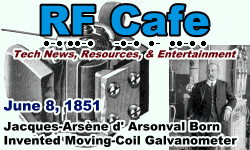|
June 8
  1625:
Gian Cassini,
after whom the division between Saturn's A and B rings is named, was born. 1786:
In New York City, commercial ice cream was manufactured for the first time. 1851:
Jacques-Arsène d' Arsonval, who invented the reflecting moving-coil galvanometers
used to measure weak electric currents, was born. 1920:
Augusto Righi,
who first showed that radio waves displayed characteristics of light wave behavior
in the manner of reflection, refraction, polarization and interference, died. 1940:
U.C. Berkeley researchers announced the creation of element 93,
neptunium (Np). 1949:
"1984,"
by George Orwell, was published. 1953: The first propane fuelled gas-turbine locomotive
was placed in service by the Union Pacific Railroad. 1955:
Tim Berners-Lee,
inventor of the World Wide Web, was born. 1959: The first official U.S. missile
mail was launched from the submarine USS Barbero at about 100 miles off the Atlantic
Coast. 1979: The Source, the first computer public information service, went online.
1995: U.S. Air Force Capt.
Scott O'Grady was rescued by U.S. Marines after being shot down
over Bosnia. 1625:
Gian Cassini,
after whom the division between Saturn's A and B rings is named, was born. 1786:
In New York City, commercial ice cream was manufactured for the first time. 1851:
Jacques-Arsène d' Arsonval, who invented the reflecting moving-coil galvanometers
used to measure weak electric currents, was born. 1920:
Augusto Righi,
who first showed that radio waves displayed characteristics of light wave behavior
in the manner of reflection, refraction, polarization and interference, died. 1940:
U.C. Berkeley researchers announced the creation of element 93,
neptunium (Np). 1949:
"1984,"
by George Orwell, was published. 1953: The first propane fuelled gas-turbine locomotive
was placed in service by the Union Pacific Railroad. 1955:
Tim Berners-Lee,
inventor of the World Wide Web, was born. 1959: The first official U.S. missile
mail was launched from the submarine USS Barbero at about 100 miles off the Atlantic
Coast. 1979: The Source, the first computer public information service, went online.
1995: U.S. Air Force Capt.
Scott O'Grady was rescued by U.S. Marines after being shot down
over Bosnia.
| Jan
| Feb | Mar |
Apr | May |
Jun | Jul |
Aug | Sep |
Oct | Nov |
Dec |
Note: These
historical tidbits have been collected from various sources, mostly on the Internet.
As detailed in
this article, there
is a lot of wrong information that is repeated hundreds of times because most websites
do not validate with authoritative sources. On RF Cafe, events with
hyperlinks have been verified. Many years ago,
I began commemorating the birthdays of notable people and events with
special RF Cafe logos.
Where available, I like to use images from postage stamps from the country where
the person or event occurred. Images used in the logos are often from open source
websites like Wikipedia, and are specifically credited with a hyperlink back to
the source where possible.
Fair Use laws permit
small samples of copyrighted content.
|









 1625:
1625:
